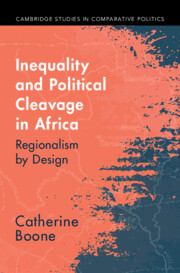Book contents
- Reviews
- Inequality and Political Cleavage in Africa
- Cambridge Studies in Comparative Politics
- Inequality and Political Cleavage in Africa
- Copyright page
- Epigraph
- Contents
- Figures
- Tables
- Preface and Acknowledgments
- 1 Economic Inequalities and Territorial Oppositions in African Politics
- 2 Region and Regionalism in African Politics
- 3 Endowment, Institutions, and Spatial Inequality
- 4 Regional Blocs and Bloc Voting in National Elections
- 5 Regional Hierarchies and Winning Coalitions
- 6 Territorial Oppositions in African Politics
- 7 Regionalism and the National Agenda
- 8 Conclusion
- Appendices
- References
- Index
- Cambridge Studies in Comparative Politics
3 - Endowment, Institutions, and Spatial Inequality
Regions by Design
Published online by Cambridge University Press: 18 April 2024
- Reviews
- Inequality and Political Cleavage in Africa
- Cambridge Studies in Comparative Politics
- Inequality and Political Cleavage in Africa
- Copyright page
- Epigraph
- Contents
- Figures
- Tables
- Preface and Acknowledgments
- 1 Economic Inequalities and Territorial Oppositions in African Politics
- 2 Region and Regionalism in African Politics
- 3 Endowment, Institutions, and Spatial Inequality
- 4 Regional Blocs and Bloc Voting in National Elections
- 5 Regional Hierarchies and Winning Coalitions
- 6 Territorial Oppositions in African Politics
- 7 Regionalism and the National Agenda
- 8 Conclusion
- Appendices
- References
- Index
- Cambridge Studies in Comparative Politics
Summary
This chapter identifies the colonial origins of the institutional structures and patterns of uneven economic development that create the template for political regionalism in African countries. Functional economic regions and administrative regions tended to align in African colonies, defining patterns of regional difference and inequality that are often strongly visible today. This process established frameworks within which politically salient ethnic identities developed, and defined political constituencies in territorial terms. With the 1940s emergence of colony-wide politics, existing administrative and political structures channeled regional interests and ideologies of regional consciousness into the national arena. A boundary persistence analysis underscores the large extent to which colonial territorial grids have been reproduced over time. I explain this persistence in terms of how African political leaders, social elites, farmers, and members of rural communities found advantage in territorial institutions forged under colonialism. These regional cleavages and the territorial institutions that help to reproduce them have structured patterns of national-level political competition in many African countries for many decades.
Keywords
- Type
- Chapter
- Information
- Inequality and Political Cleavage in AfricaRegionalism by Design, pp. 48 - 89Publisher: Cambridge University PressPrint publication year: 2024

